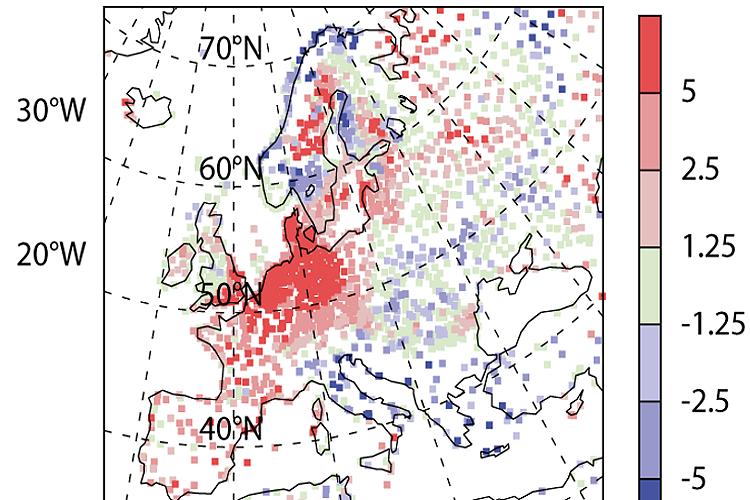Process-oriented understanding of weather forecast error
Despite huge progress made in numerical weather prediction, occasionally severe forecast errors occur affecting large regions. In Europe, such “forecast busts” are related to a misforecast of the large-scale circulation over the Atlantic-European region. An example on how this affects 2m temperature forecast over Europe is shown in Figure 1. In this six-day forecast issued on 07 March 2016, the model predicts too mild conditions for wide parts of western and Central Europe whereas it predicts too cold conditions in Italy and the Balkans (Figure 1; note that data from more weather stations is available in central Europe and thus the density of available surface observations is much higher there).
The March 2016 forecast bust was related to the onset of a stationary high pressure system over the North Sea region – a so-called European blocking regime. Such weather regimes typically last for several days to a few weeks and affect entire Europe. Thus, it is important to understand why numerical models struggle in correctly predicting their life cycles.
In a recently published study [1], we now reveal that condensational processes associated with the warm conveyer belt (WCB) of an extratropical cyclone effectively amplify a small error early in a weather forecast and projects it on the large-scale circulation resulting in the severe forecast bust for entire Europe for the later forecast hours.
The group now investigates if this is a singular case or if WCBs and other processes acting on weather time scales generally dilute forecast skill for the large-scale weather regimes on medium-range to subseasonal time scales (10-30 days). Therefore, we investigate dynamical processes driving weather regime life cycles using reanalysis and historical weather forecast data. This includes the investigation of how slower climate modes such as the stratosphere, the ocean state, or the Madden-Julian-Oscillation affect predictability of weather regimes [2] and how weather regimes modulate surface weather on subseasonal time scales [2,3].
The group is funded by the Helmholtz Association with a Helmholtz Young Investigator Group Grant for the project “Subseasonal Predictability: Understanding the Role of Diabatic Outflow” (SPREADOUT).
Link: Group „Large-scale Dynamics and Predictability“ http://www.imk-tro.kit.edu/english/7425.php
[1] C. M. Grams, L. Magnusson, and E. Madonna, An atmospheric dynamics‘ perspective on the amplification and propagation of forecast error in numerical weather prediction models: a case study. Quarterly Journal of the Royal Meteorological Society, in press, doi:10.1002/qj.3353 (2018).
[2] C. M. Grams, R. Beerli, S. Pfenninger, I. Staffell, H. Wernli, Balancing Europe’s wind-power output through spatial deployment informed by weather regimes. Nature Climate Change. 7, 557–562, doi:10.1038/NCLIMATE3338 (2017).
[3] L. Papritz, C. M. Grams, Linking Low‐Frequency Large‐Scale Circulation Patterns to Cold Air Outbreak Formation in the Northeastern North Atlantic. Geophysical Research Letters. 45, 2542–2553, doi:10.1002/2017GL076921 (2018).

